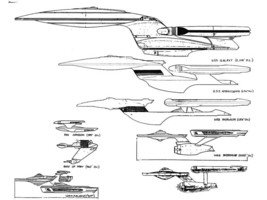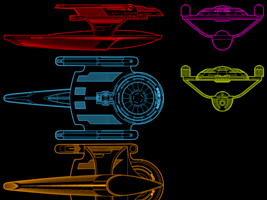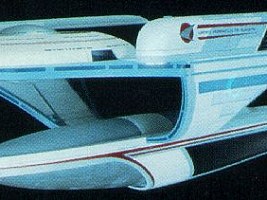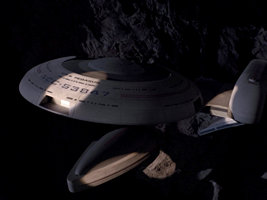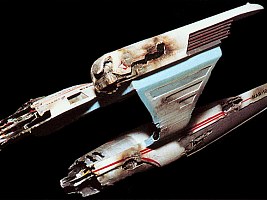Size of the Oberth Class
by Bernd Schneider and Chris Spinnler
The first Oberth-class ship to appear in Star Trek was the USS Grissom in "Star Trek III: The Search for Spock". The ship is 395ft or 120m long on the ILM size chart for the movie, and a few meters longer according to the depictions in the Star Trek Encyclopedias I and II. Since there is always some margin of error in a printed reproduction, and especially the smaller ships are likely to be scaled up, we may presuppose that it was meant to be 120m long in the Encyclopedias too.
There are a couple of problems with this ship class, which may not allow to maintain such a small size. 120m would be too small to justify its inner and outer appearance on screen.
Studio Model
Deck heights
The depictions of the Oberth class in the Star Trek Fact Files diagrams and the Star Trek Encyclopedia II are not congruent, and neither of them seems to be a completely reliable reproduction of the ship's actual look. Aside from several parts of the ship whose proportions differ, the Fact Files diagrams show one row of windows in the upper half of the saucer and one row in the lower half, as opposed to the Encyclopedia rendition, on which both rows are in the upper half of the saucer.
Reference photos or screen caps of the Oberth class reveal that the lower window row is actually located halfway down the saucer. This may imply that there were originally supposed to be more than two decks in the saucer, but that's just not possible if the ship is only 120m long. The same studio model was used for all intact incarnations of the class, only the name and registry was changed occasionally. The Pegasus too is represented by the undamaged miniature. It was embedded in a"rock" made of styrofoam, as recently confirmed by Dan Curry.
The dilemma is that, taking the Star Trek Fact Files diagram as a reference, the saucer (without the bump on the top) would be only 6m tall at 120m overall length. Subtracting the required thickness for two times the outer hull and one deck floor, the clear height of the saucer couldn't be more than just enough for two decks of only 2.5m height. In addition, the cargo loading ports (or shuttlebay doors?) wouldn't be taller than only 2.3m in this case. The bow port, BTW, is completely missing on the Fact Files diagram, and the lateral ports are much too small. The window arrangement would be really silly on a 120m Oberth, the lower row being just between the decks 1 and 2. We may assume that, for some reason, it was not possible to provide deck 2 with windows, and the windows, together with the ceiling, were moved up to act as "skylights". Maybe there are sensors and EPS conduits in the outer hull on this deck that didn't allow to install any windows. Anyway, since they can hardly be used for lighting, what would those skylights be useful for, except for providing the crew with the sight of the stars while lying in bed?
If we look at deck 3 underneath the main saucer hull, it would be hardly 2.3m tall overall, and would have less than 2m clear heigh. This is definitely not enough for a full deck. It is possible that this deck is only used for power transfer conduits to the warp nacelles, for the fusion reactors, sensors, and other uninhabitable areas. Anyway, it is not evident why it was not designed in a way to provide at least a full room height, like on every other Starfleet ship too. The actual photos of the Oberth suggest that this deck could be taller indeed. Especially in The Art of Star Trek it seems as if this deck might be almost half as tall as the saucer.
Lower section
Another problem is how the lower portion of the ship can be accessed. Of course, this also depends on what is actually located down there. There are no windows and nothing else that could indicate that it's a permanently inhabited area. The deuterium tank may occupy the upper part. If the engine room is in the lower hull, the power transfer conduits would have to go up all the way from the lower hull to the nacelles. On the other hand, if the warp core is located in the upper hull, probably both the matter (from the presumed deuterium tank) and the antimatter would have to be routed through the pylons. In either case the Oberth is a poor design.
No matter if the lower hull has to be frequently accessed or only a few times per day, we wouldn't consider that the transporter is used for that purpose each time. Especially if we consider that the Oberth is a dated design, we have to keep in mind that, at the times of TOS, intra-ship transport was regarded as dangerous (mentioned e.g. in TOS: "Day of the Dove"). There may be some sort of dedicated transporter channel between the upper and the lower hull to minimize the risk, but there's no reason not to make the pylon wide enough for a small vertical turbolift channel instead. Yet, if we postulate that the turbolifts are running through the pylons, we get serious problems. The pylon thickness appears to be less than 1.8m on the Fact Files front view, and the actual photos support this impression. A tiny 1m x 2m turbolift car could barely fit through such a channel, and it would be impossible to make it follow the curves, let alone technically sensible. Moreover, the car would depart vertically in the upper hull and arrive horizontally in the lower hull, and it would have to be turned by 90° again upon arrival. The change of the direction of gravity, on the other hand, would be no problem, considering that the car has its own gravity generator. Anyway, the designer of such a turbolift must be a complete idiot! Or does the ship rather have a pneumatic delivery system like in "Futurama"? ;-)
Screen Evidence
Interior
Several interior sets of different ships of the Oberth class appear on screen. "Star Trek III" shows a standard-size Starfleet bridge on the USS Grissom, actually just a slight redress of the Enterprise bridge. The bridge of the USS Yosemite in TNG: "Realm of Fear" is a wholly different design by looks equally spacious, although it just a partial set was built. While it might have been the original intention that the bridge should occupy exactly the shallow dome on the top of the saucer, this is impossible on a 120m ship, since the dome would be less than 2m tall. There are two rows of light in the dome, but if there were actually two decks, it would require a 360m long ship. So at 120m length there is no other possibility but to assume that the bridge is not exposed, but occupies the central portion of the upper half of the saucer, with the dome providing some extra room height.
The interior of the Tsiolkovsky is visible in TNG: "The Naked Now". It is evident that the already existing sets of the Enterprise-D, originally built for the Enterprise refit, are used, including the corridors with their characteristic cross-section. Thus, the Tsiolkovsky should have the Starfleet standard deck height of at least 3m. Since the away team is looking around in crew quarters and other inhabitable areas of the ship, this is very likely inside the saucer hull. On a related note, the door labels in the episode start with "07-", insinuating that the rooms are located on deck 7, although having seven decks in the saucer seems impossible. Also, 4-digit room numbers on such a small ship doesn't seem to be plausible.
TNG: "Interface" shows another room inside an Oberth-class ship, once again with a ceiling height of more than 2.5m. The USS Raman was originally intended to be a different ship class. Anyway, since we can't prove otherwise and the whole issue doesn't depend on the set shown here, we shouldn't take into account the doubts about the ship's class.
Finally, in TNG: "Pegasus", we are shown the engineering room of the Oberth class, with a clear height of almost 4m in the center. It is not completely certain, but the engine room was probably supposed to be in the less damaged saucer section of the ship. It is evident that none of these rooms could be located in a two-deck saucer hull of a 120m Oberth class, and it is questionable that any of them should have been in the more or less isolated lower section of a 120m Oberth. Summarizing, all interior sets clearly support a larger size than 120m.
Exterior
The heavily damaged S.S. Vico from TNG: "Hero Worship" has four decks in the saucer. Greg Jein, who damaged the model, obviously paid attention to the window arrangement and assumed that the two visible window rows belonged to deck 2 and deck 4 of the saucer, deck 1 being the bridge dome. This would work well for a ship of at least 300m. Almost 300m is the size at which the USS Tsiolkovsky appears next to the Enterprise-D in TNG: "The Naked Now". Moreover, given the crew complement of 80, as stated in the same episode, only a ship of this large size could provide all the room for crew quarters and labs in the relatively small saucer. At the end of "Star Trek: Generations", however, the Oberth is only 120m (at most), compared to the Nebula-class Farragut. This is the last appearance of an Oberth-class in live-action Trek.
More evidence may come from the explosions of the USS Grissom in "Star Trek III" and of the USS Bonestell in DS9: "Emissary". When the torpedo from the Klingon BoP hits the sloping side of the engineering hull, the ship explodes in an instant. This is one more sign that a volatile substance, namely deuterium, is likely stored in this part of the ship. The Bonestell breaks into two parts, the upper and the lower hull. Maybe the primary hull can separate like on other ships too? In this case it would make more sense if the warp core were in the primary hull, for this would still be a fully operational ship with warp nacelles. I think something similar of the strange Curry too.
MSD
The best canon size reference available is a master systems display (MSD) that can be seen in "Hero Worship", but unlike Greg Jein's model from the same episode, has only two decks in the saucer section. Since the MSD largely corresponds with the deck structure I conceived before I saw the MSD, it is obvious that there would be basically the same problems with the window spacing, the height of deck 3, the loading ports, and the access to the secondary hull. As expected, the bridge occupies the center of the first deck in the saucer superstructure. The computer core is directly below the bridge on deck 2 and it was explicitly called so in the episode.
Deck 3 is definitely inhabitable on the MSD. It seems to be thicker than on the Fact Files depiction, where it was only one third of the saucer height. A closer look reveals what is actually wrong. I have superimposed the Fact Files diagram (with my deck structure) on the MSD. While I probably couldn't entirely compensate for the viewing angle of the MSD screen cap, it is obvious that the saucer is thicker on the Fact Files diagram. If the MSD is correct and the ship is not shorter (which is still a possibility taking into account the viewing angle), this aggravates the problem, since most decks, including deck 1 and deck 2, would be like deck 3. They would be at most 2.3m tall, and would have only 2m clear height at 120m length. The pylons are divided into six decks, counting from the saucer bottom to the upper edge of the rim around the secondary hull. This differs from my above reconstruction where there are only four decks, but it can be explained by the reduced deck height likewise. For the same reason the lowermost deck is now inhabitable too.
The upper part of the secondary hull is obviously occupied by deuterium tanks. The warp core is located in the secondary hull too, which raises the problem that this section was barely outside the rock in TNG: "The Pegasus". There is probably a matter injector in between the fore and aft tank, as it would make perfect sense. There seems to be a two-deck aft shuttlebay with a shuttle, but a corresponding shuttlebay door is missing on the model. There is only a round opening looking like a deflector pointing in the wrong direction. On the other hand, this could be a shuttlebay door working like the shutter blade of a camera, if it were not so small. The red areas on the MSD could be anything, but most likely they denote damaged sections. I don't have a good starboard view of Jein's model. In case the damage pattern on the miniature should look worse, or otherwise shouldn't match the MSD, we could argue that the red areas actually show sections that are not only damaged, but without forcefields or without life support. The red area between the warp core and the presumed shuttlebay, occupying three decks, has a slightly different color. This could be could be an undamaged secondary computer core.
Dialogue
The USS Biko is identified by Data as a "freighter" in TNG: "A Fistful of Datas". The ship, like the Raman too, could have been intended to be of a different class. Anyway, the Oberth design doesn't look anything like a freighter. Even if we assume the ship is much larger, it would be hard to convert from a science ship to a freighter, as opposed to the Miranda-class USS Lantree that was both large enough and practical enough with its compact hull shape and large shuttlebay doors to be a cargo or supply ship. The cargo hold on the Oberth could be in the secondary hull, but there is nothing that could be a docking port or cargo bay door.
On another note, in "Star Trek III" Chekov mentions a "scout class vessel" on his sensors (actually the cloaking BoP) when he may have expected to see the Grissom. A scout would definitely have to be a lot smaller than the Enterprise, and rather in the same size range as the BoP, which Chekov may have mistaken as the Grissom at the first glance.
Conclusion
The Oberth was always intended to be a very small ship and definitely not the same size or even bigger than the Enterprise NCC-1701, but its appearance is neither technically reasonable, nor does it support the intended size of 120m. The ship obviously wasn't carefully designed by ILM. It is possible that, while there are several design stages of the Excelsior (and even the final Excelsior has several design flaws), they didn't care about the Oberth as much. We have to disregard the two window rows in the small dome on the saucer that would require a 360m long ship if there were really two decks in it. This compromise is necessary on the original Constitution, the Constitution refit and the Excelsior too, where the window rows don't exactly match with the deck structure either. Agreed, it's worse in the case of the small Oberth. Maybe the rectangular lights are actually no windows, but sensor pallets?
Anyway, the inconsistent window rows may have been one reason why the ship was scaled up for several TNG episodes to about 300m, most notably by Greg Jein who "destroyed" the U.S.S Vico - whereas the MSD in the same episode showed a considerably smaller ship. The other reason may have been that the 120m Oberth would have looked just too small beside the huge 642m Galaxy class. Finally, someone may have noticed that the interior sets don't work at 120m. A few years later, the 120m ILM length was established in sources such as the Star Trek Encyclopedias. The Oberth class seen in "Generations" appeared at 120m again. Could this have to do with ILM creating the visual effects for the film?
If the Oberth were only 120m long, there would be only two complete decks of only 2m clear height inside a saucer of 39m diameter for the lower deck and 32m for the upper deck, respectively. The small saucer would have to include the standard-sized bridge, a computer core, quarters for 80 crew members, three cargo bays and, of course, several science labs as we expect it on a dedicated science ship. The window arrangement with the useless "skylights" for the lower deck, at the expense of some area in the upper deck, seems idiotic, unless it's something else. No need to mention that the Lilliputian decks of the 120m ship would not match what we have seen as interior sets in "Star Trek III" and four TNG episodes.
While we have to disregard one of the contradictory size comparisons in TNG: "The Naked Now" and "Star Trek: Generations" and one of the two versions from TNG: "Hero Worship" anyway, we may find a compromise for the deck count and size. These are the proposals:
120m - two decks The very small Oberth has all the problems listed above. The only benefit of this size is that it would match with the small "Generations" Oberth, but it would not be inhabitable.
150m - two decks If we stick to two decks in the saucer, 150m would be required to provide reasonable deck heights, matching what we have seen inside the ship. The problems with the cargo bay doors and the turbolifts would be mitigated a bit. The vessel would be somewhat larger, but still overall quite small for a crew of 80 and all the required equipment.
220m - three decks The ship could have three instead of two decks in the saucer. This would solve the issue with the window rows. The cargo bay doors would be tall enough, but they would occupy one and a half decks. The ship would have to be more than 200m long in this case, rather 220m, to provide reasonable deck heights. The bridge still couldn't be located in the dome, but would have to be submerged into the saucer. We would have to disregard both the 2-deck MSD and the four deck model by Greg Jein.
220m - two decks plus Jefferies tubes It may be possible to reconcile the model and the MSD of the Vico interpreting two of the four apparent decks on the model as Jefferies tubes. Knowing that Jefferies tubes are not consistent with MSDs on other ship classes either, this would not really be a stretch. However, it would require to inflate the vessel to a similar size as if it had three decks.
300m - four decks The ship would have to be further increased to allow four decks in the saucer, and to allow an exposed bridge module like on any other ship of that era. At 300m, finally, the design problems would be largely solved, but the ship wouldn't be anything like it was originally supposed to be. In particular, it seems unlikely that the Constitution refit, as the capital ship of those days, wouldn't be significantly larger than the Oberth.
Summarizing, there is no doubt that the ship would work better at an increased size. It seems as if a compromise which may eliminate at least the most pressing problems, while not enlarging the ship too much, is most desirable. The four decks in TNG: "Hero Worship" were hardly visible anyway and were contradicted by the MSD in the same episode. Although the ship would still be very crammed, especially inside the saucer, I am inclined to accept 150m as a viable compromise.
See Also
Starship Gallery - Various Starfleet Vessels
Credits
Thanks a lot to Timo Saloniemi, Rocky Steinhaus, Colin Lindsly, Adam Newton and Eicos for additional material and suggestions. Special thanks to Jörg Hillebrand who supplied many update pictures. Thanks also to Stuart Lynn Sexton for correcting the quote about the "scout class" (actually from Chekov).

Back to Starship Articles index







 USS Grissom in "Star Trek III"
USS Grissom in "Star Trek III"